- Home
- Top German Cities To Visit
- Things to do in Heidelberg
Things to do in Heidelberg: Amazing must-see attractions
By: Eran Fulson / Traveler & Blogger / After 15+ years of travel across North America and Europe, I now help travelers experience Germany beyond the guidebooks with firsthand tips and cultural insights.
Heidelberg, the little brother to some of the most romantic cities like Paris and Venice, comes in nipping at their heels. Renaissance architecture emanates throughout the beautiful city as if walking through a time capsule. As it was in the past, the present day also has plenty of things to do in Heidelberg.
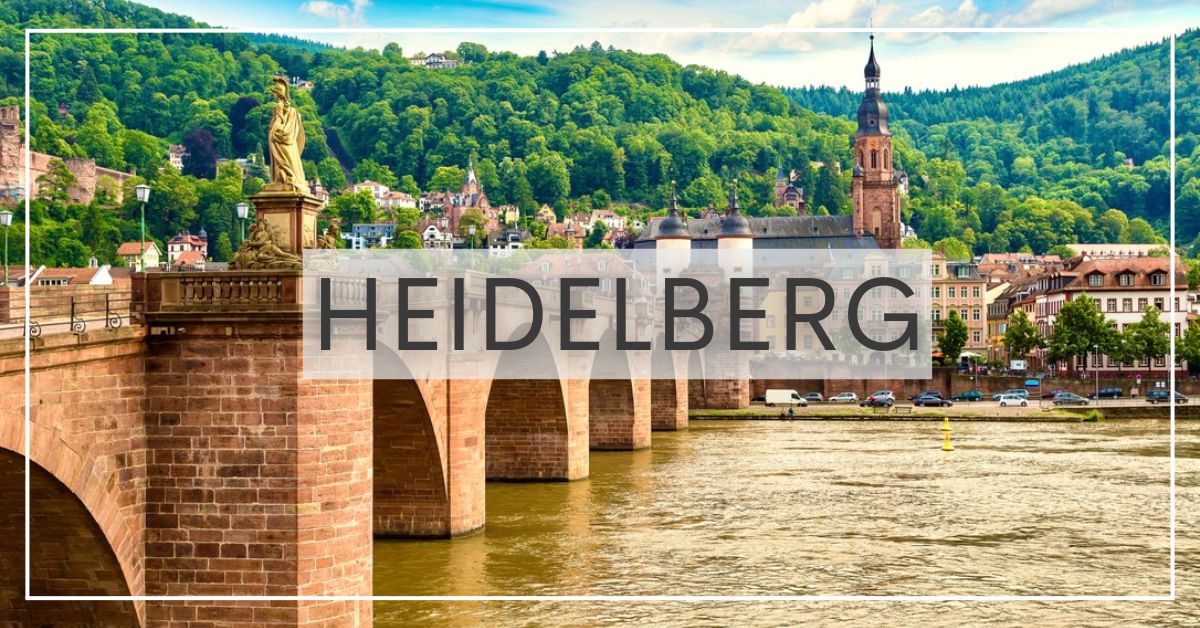
On this page:
Though modern amenities now wrap around the historical dwellings, it takes little imagination to visualize oneself back to the early 13th century.
These days, Heidelberg is a highly regarded university town, with its student population making up nearly a quarter of its residents. This gives the city a youthful energy among the centuries-old sandstone buildings.
Unlike many cities in Germany, Heidelberg escaped World War II without any major destruction. In 1945, Allied forces captured the city and it became the headquarters for the US Army in Europe and NATO.
Heidelberg’s history is closely intertwined with the castle and university, both established in the 1300s. In the years that followed, the city became synonymous with poets and philosophers and has since rooted itself among the world leaders in biotechnology.
Getting There & Around
Heading on into the many things to do in Heidelberg is the D-Bahn (Deutsche Bahn - Train). Once you’re in, buses and streetcars running from the central hub at Bismarckplatz will see you through the city without the stress of navigating yourself. But if you’re someone who likes a challenge, then you crack on my friend. You crack on.
 Railway into Heidelberg
Railway into HeidelbergDue to Heidelberg’s relatively small footprint, getting around the city is less arduous than in the likes of Cologne, Frankfurt, or Munich. Unless you’re coming in by car, then I wish you all the best, as finding a parking spot is like playing whack-a-mole without a hammer.
Seriously though, a good pair of shoes or a bicycle will get you to most places at a leisurely pace, while taxis and buses will get you anywhere else a little quicker.
We've partnered with Stay22 to help streamline your holiday booking experience. Using the interactive map below, find your next home away from home. Also added are points of interest that we cover in this post.
Oh Castle, My Castle
Schloss Heidelberg (Heidelberg Castle) strikes a commanding pose three hundred feet above the city on Königstuhl Hill. Its red sandstone walls have contrasted against the surrounding dark green forests since 1225 A.D. and tops our list as one of the best things to do in Heidelberg.
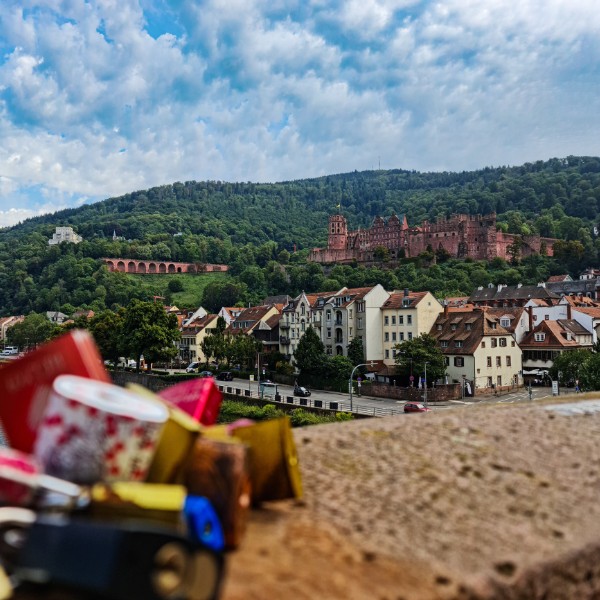 Heidelberg Castle and love locks on the Alte Brücke
Heidelberg Castle and love locks on the Alte BrückeTo say the castle has had a tumultuous history would be putting it lightly, but then again, a peaceful castle is akin to a quiet seagull: theoretically conceivable while highly improbable.
For nearly four hundred years, Heidelberg Castle stood as the pinnacle of Renaissance castles in the Holy Roman Empire. The inner workings of the castle were highly influential beyond its borders as well, operating as a residence for prince electors in the electoral college that chose the emperor for the Empire.
Then came the Thirty Years War in 1622, the beginning of the end of an era. Near total destruction during the war was followed by two more notable assaults by the French in 1688 and 1697. Though rebuilding began immediately following the attacks, complete reconstruction was never seen.
The final blow came from the forces of nature in 1764. During repairs, two devastating lightning strikes started a fire in the castle that left the once-proud estate in ruins. It wasn’t until 1900 that the castle was restored. Though some ruins still remain, leaving a solemn effigy to its legacy.
 A bit of filler and it's good as new...
A bit of filler and it's good as new...interesting fact
Out on the Great Terrace, there is a deep shoe-shaped imprint in the sandstone floor. Legend has it that a knight leapt from a window in Friedrich’s Wing and left the depression as he landed. Allegedly, if your foot fits the imprint, you can expect to live a happy life – though this claim has been disputed during the baby-wailing flight back home.
Undoubtedly, as impressive as the residence itself, the castle grounds are awe-inspiring in their own right. Called the Hortus Palatinus, the Heidelberg Castle gardens were once touted as a contender for the eighth wonder of the world.
Its geometrical layout, landscaped gardens, statues, and water features offer this as good a place as any to admire the surroundings and get your step count up.
Inside the castle is a rather notable global achievement: the world’s largest wine barrel. Built in 1751 as a tax coffer (the area was a thriving wine region; therefore, taxes were often paid in local wine) and standing at a height of 23 feet (7 meters), it can hold 58,118 gallons (220,000 liters) of wine.

Also in the castle is the Deutsche Apotheken-Museum (German Pharmacy Museum). Two thousand years of pharmaceutical history detail how medicines were taken from their raw herbal form and processed into viable medications (though some were hit or miss).
There’s also a museum shop selling replicas of bottles, vials, mortars, and candy – obviously.
 A potion for any occasion.
A potion for any occasion.And lastly, as if the history of Heidelberg Castle wasn’t enough in itself, getting there is also a spectacle. Although driving to the castle isn’t recommended as parking is limited.
So, unless you’re willing to play a bit of roulette with your holiday, the Heidelberg funicular railway starts at the Kornmarkt in the old town and makes one of its stops at the castle. Carry on past the castle, and you'll be rewarded with views across the Rhine Valley and vineyards as the railway makes its way up the Königstuhl.
Sparing no feelings, the ride up the hill to the castle is a little nondescript. Despite that, still beats walking up. Plus, if you have kids they'll love it.

Alte Brücke - Monkey Biz
Spare a thought for Karl Theodor. In 1788, the Elector had a bridge commissioned and named it after himself, though the name didn’t stick. Instead, it is now known as the Alte Brücke (Old Bridge).
A rather dull-by-comparison bridge just up the Neckar River is now called the Karl Theodor Bridge. Although there is some solace in it being a vital transport link, it is still bland as bland can be.
The Alte Brücke, however, is far from dull. If not simply for a sculpture of the Heidelberg bridge monkey, seemingly judging every passerby as you make your way on. Rubbing the mirror it holds is said to bring you wealth, and rubbing the nearby bronze mice alleges fertility.
To date, little gilded babies running around has yet to be confirmed, so an obligatory selfie is probably all you’re getting out of him.

From an architecturally romantic perspective, however, the red sandstone bridge is a landmark feature of the city. Like many visitors to the city, strolling along and taking in the view from the bridge is one of the most popular things to do in Heidelberg. It may sound like an odd passing of time, but crowds don't lie.
Connecting the Old Town to the Neuenheim district were eight previous iterations of the current bridge. Previously, wooden structures were regularly succumbing to war and ice flows before the bridge was finally constructed out of stone by the aforementioned Theodor.
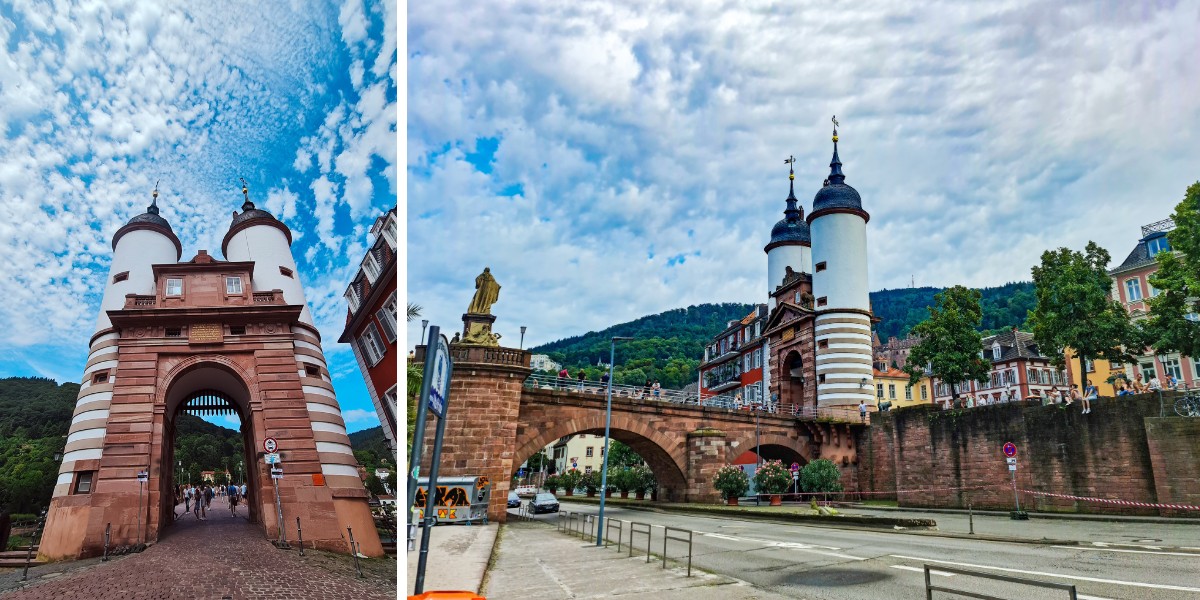
On the Old Town side is the Medieval Bridge Gate. This ornate twin tower gate is the lone survivor of several previous bridges and was used as a guard house and jail known as Schuldturm (Guilt Tower). Like many other landmarks in the city, it's worth a photo or two - without the punishable guilt.
Heiliggeistkirche - Three’s a Crowd
Heidelberg’s Heiliggeistkirche (Church of the Holy Spirit) has had a rather unique arrangement over the years. Two previous churches stood where the current one (circa 1398) stands in the middle of Heidelberg’s Old Town.
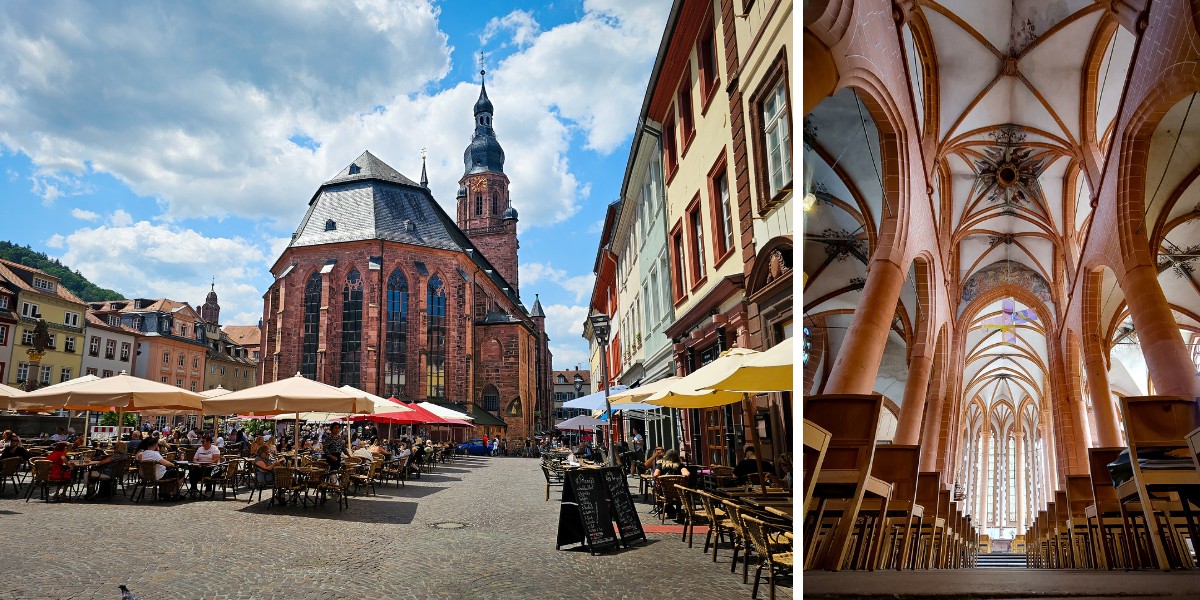 Views of the Heiliggeistkirche from our summer tours.
Views of the Heiliggeistkirche from our summer tours.Over the next five hundred years, the church changed between Catholic and Protestant several times before both laid an unshakable claim to the building. A wall was eventually put up, and Catholic mass was held in the chancel and Protestant services in the nave.
In 1936, Pastor Hermann Maas reached an agreement, thereby giving possession of the church to the Protestant Church in Baden. And the wall separating the church for more than two hundred years was removed.
Heidelberg University - School of Hard Knocks
The University of Heidelberg is Germany’s oldest university, founded in 1386, and one of the most prestigious in Europe. It is commonly referred to as the Ruperto Carola after its founder, Elector Ruprecht I of the Palatinate, and Pope Clement VI, who granted its establishment in the Holy Roman Empire.
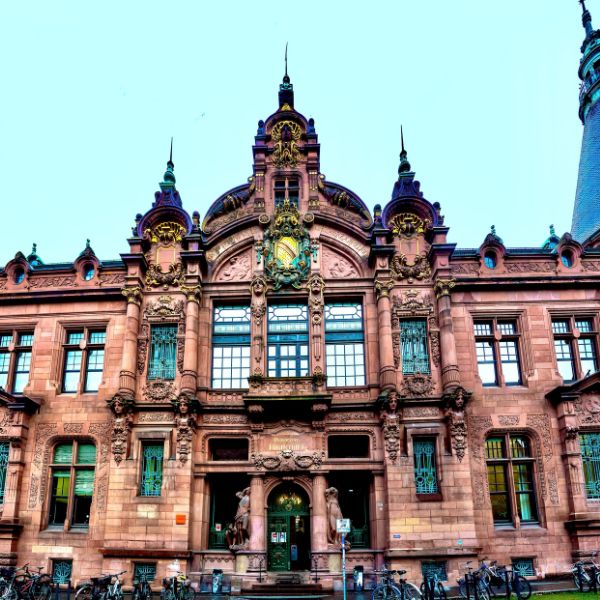
The university became a highly-regarded center for humanism, liberality, and openness to new ideas. With the exponential growth, however, came a double-edged sword. As the student population grew, so did the disciplinary procedures.
Public order offenses and night-time carousing were handled by a cooling-off period in the student prison. Established in the 1780s and functioning until 1914, the student prison was a catch-all for any offenses deemed to contradict the university’s moral code.
Today, the prison is a popular tourist attraction in Heidelberg and makes every childhood visit to the principal’s office feel mild by comparison.
 Those gates are a perfect lesson for 'Measure once, cut twice.'
Those gates are a perfect lesson for 'Measure once, cut twice.'Heidelberg University isn’t all liberalism and hard knocks. The university’s botanical gardens have been offering a holistic and tranquil escape since 1593, making them one of the oldest in the world.
Inside the 43,055-square-foot greenhouse are nearly 5,000 cultivated and endangered species of flora. Outside, you’ll find a fern canyon, an alpine plantation, and numerous other landscaped grounds to explore.
Thingstätte - Propaganda Drama
INTERESTING FACT
The acoustics of the amphitheater were so well designed that a normal speaking voice on stage could be heard over 650 feet away.
Just a short hop over to the Heiligenberg (Holy Mountain) is the Heidelberg Thingstätte (Government Assembly Site). The Thingstätte is an amphitheater constructed during Joseph Goebbels’ Thingspiel initiative. Completed in 1934, the site provided a literal platform to indoctrinate the population into National Socialism (Nazism).
While accomplishing its purpose in the early days, with twenty thousand people turning up on the opening day, the amphitheater quickly became obsolete as Nazi propaganda switched to radio broadcasts and the site was abandoned.
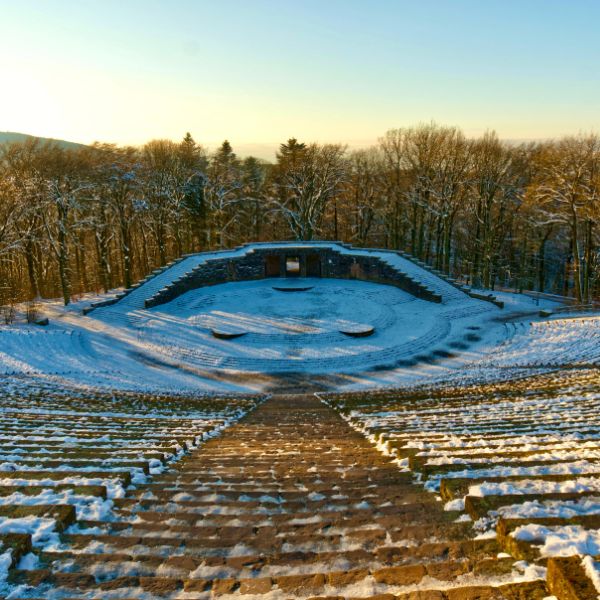
Shop Till You Drop
This is right up there among Europe’s longest and oldest shopping streets. Of all the things to do in Heidelberg, the Hauptstrasse (Main Street) is 1.1 miles of retail bliss. You’ll find everything from familiar brands to smaller independent shops accompanied by a range of local and international dining spots.
Various expansions in the Old Town from the 1300s have led to the main shopping street becoming a largely pedestrianized zone. It's still advisable to look both ways for anyone walking with more intent than yourself.

If you’re not keen on breaking out your wallet every five minutes, the Hauptstrasse is also home to several notable historical buildings. Highlights include the aforementioned Church of the Holy Spirit and the Haus zum Ritter (House of the Knight).
I’m also inclined to note that City Hall, which, if I’m brutally honest, is quite an appealing building from the outside but lacks much of anything touristy on the inside as it still functions as City Hall.
Unless you have an affinity for formal letterheads regarding waste collection and the inner workings of local council bureaucracy - such eagerness will most likely see you hastily escorted from the premises.

Things That Go Bump in the Knight
Laying claim to the oldest surviving building in Heidelberg belongs to Haus zum Ritter St. Georg (House of the Knight St. George). Built in 1592 by French Huguenot Charles Belier, it has been used as a hotel since 1681 and still functions as one today. The house withstood the Thirty Years War which decimated the city, and the War of Succession that destroyed whatever was left.
A marvel of Renaissance architecture, Haus zum Ritter is famous for its elegant facade with ornate carvings, fluted columns, and adorned with golden Latin inscriptions.
Sadly though, the national propensity for giving location names very literal translations (Notably, Rothenburg - Red Castle on the Hill, and Dresden - People From the Forest by the River) ends with the House of the Knight.
There is a noticeably distinct lack of knights aside from the bust of Knight St. George at the top of the building. That said, it really is quite a remarkable building.
Philosopher's Walk - Stretch Your Legs
Much has been made of the things to do in Heidelberg given the notable historical landmarks with Renaissance architecture and the air of a romantic city. However, take a stroll away from the bustle of town, and you’ll find another avenue of inspiration for past wordsmiths and philosophers.
Aptly named Philosophenweg (Philosopher’s Walk), this humble path on the northern banks of the Neckar River leads through the vineyards and into the Old Town side of Heidelberg. The path was said to inspire famous German poets Friedrich Hölderlin and Joseph von Eichendorff, among a litany of others, in their search for solitude and reflection.
The walk offers incredible views of the Old Town with places to stop along the way and contemplate the essence of life immemorial, as many previous scholars have done along this stretch.

INTERESTING FACT
The Medlar tree was once widespread in medieval Europe with the fruit it produces often used in wine-making.
Connecting the Alte Brücke to the Philosophenweg is the Schlangenweg (Snake Path). Taken with a calming pinch of salt, this walk is not named for the presence of snakes (fabled or present), but instead for the snake-like winding nature of the path.
Flanked by red sandstone walls, this path was once part of a vineyard in the old village of Neuenheim. Though the vineyard has long been replaced with gardens and an ever-expanding city, Medlar trees still proliferate along the sides of the Schlangenweg.
Christmas in Heidelberg - Deck the Halls
For all the things to do in Heidelberg, a wintery experience with the backdrop of the infamous castle is second-to-none. Packing all the appeal of multiple Christmas markets found in a large city, in one not-so-large city, yet still with multiple markets. Six, to be a little more precise and each with its own bit of flair to lure you in. They are, *deep breath*...
- The Bismarckplatz - Entrance to the Old Town and has a solid bit of Christmas flair.
- The Anatomiegarten - Loads of festive huts.
- Universitätplatz - Situated on the largest square of the bunch, an antique carousel will keep the kids entertained while parents fill themselves with bratwurst and mulled wine.
- Marktplatz - Notable for its large traditional Christmas pyramid and a larger-than-the-original replica of the already large Heidelberg Tun.
- Kornmarkt - Nativity scene and miniature train are sure to keep the kids preoccupied if they’ve forgiven you for leaving them at the Universitätplatz Carousel.
- Karlsplatz - The kind of Christmas market that just came to mind when you read the words, Christmas Market—except it has Heidelberg Castle illuminated in the nearby background. Also, it has its own ice rink. Grab some skates and flex those strides.
 Deck the festive halls.
Deck the festive halls.Final Musings of Things to do in Heidelberg
Emerging largely untarnished from war and modern architectural supplantment, this charming old town of Heidelberg is the perfect place to go for beautiful scenery and a variety of top attractions.
Spectacular views as you make your way into town are only trumped by walking the narrow streets and rubbing shoulders with the red sandstone buildings forever etched with history. It's worth a trip if only to see what all the fuss is about. And for that, with all the things to do in Heidelberg, it does not disappoint.
Is Heidelberg, Germany worth visiting?
Is Heidelberg, Germany worth visiting?
Absolutely! Heidelberg is a must-visit destination for its rich blend of history, architecture, and scenic beauty. The city's iconic Heidelberg Castle, perched on the Königstuhl hillside, offers breathtaking views of the Neckar River and the Altstadt (Old Town).
Renowned as a university town, Heidelberg also has a lively atmosphere, with cobblestone streets lined with cafes, shops, and historical landmarks like the Old Bridge (Alte Brücke). Whether you're a history enthusiast, a romantic traveler, or a photography lover, Heidelberg has something to enchant everyone.
What is Heidelberg best known for?
What is Heidelberg best known for?
Heidelberg is best known for its historic Heidelberg Castle, one of the most significant Renaissance structures in Germany. Beyond the castle, the city is famous for its prestigious university, which dates back to 1386 and remains one of Europe's oldest and most respected institutions.
Heidelberg is also recognized for its charming Old Town, filled with architectural gems, including the Church of the Holy Spirit (Heiliggeistkirche) and the Philosophers’ Walk (Philosophenweg), where visitors can enjoy stunning panoramic views of the city and surrounding landscape.
Is one day in Heidelberg enough?
Is one day in Heidelberg enough?
While you can get a taste of Heidelberg in one day, including visiting the Heidelberg Castle, strolling through the Old Town, and taking a leisurely walk along the Philosophers' Walk, you might feel rushed.
To truly appreciate the city's charm, consider staying overnight to explore more leisurely. This allows you to enjoy Heidelberg's vibrant dining scene, experience a romantic evening by the Neckar River, and delve deeper into cultural landmarks, such as the Student Jail (Studentenkarzer) and the German Pharmacy Museum.

